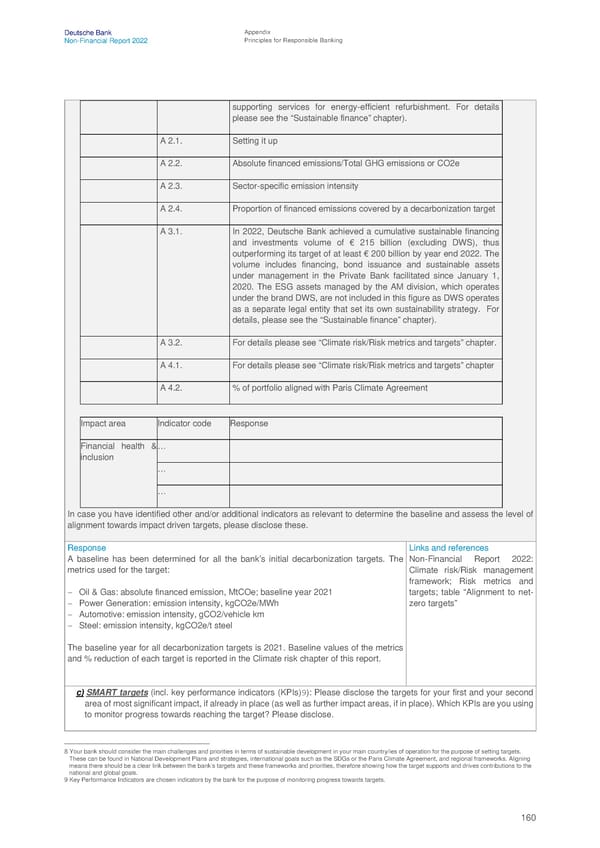Deutsche Bank Appendix Non-Financial Report 2022 Principles for Responsible Banking supporting services for energy-efficient refurbishment. For details please see the “Sustainable finance” chapter). A 2.1. Setting it up A 2.2. Absolute financed emissions/Total GHG emissions or CO2e A 2.3. Sector-specific emission intensity A 2.4. Proportion of financed emissions covered by a decarbonization target A 3.1. In 2022, Deutsche Bank achieved a cumulative sustainable financing and investments volume of € 215 billion (excluding DWS), thus outperforming its target of at least € 200 billion by year end 2022. The volume includes financing, bond issuance and sustainable assets under management in the Private Bank facilitated since January 1, 2020. The ESG assets managed by the AM division, which operates under the brand DWS, are not included in this figure as DWS operates as a separate legal entity that set its own sustainability strategy. For details, please see the “Sustainable finance” chapter). A 3.2. For details please see “Climate risk/Risk metrics and targets” chapter. A 4.1. For details please see “Climate risk/Risk metrics and targets” chapter A 4.2. % of portfolio aligned with Paris Climate Agreement Impact area Indicator code Response … Financial health & inclusion … … In case you have identified other and/or additional indicators as relevant to determine the baseline and assess the level of alignment towards impact driven targets, please disclose these. Response Links and references A baseline has been determined for all the bank’s initial decarbonization targets. The Non-Financial Report 2022: metrics used for the target: Climate risk/Risk management framework; Risk metrics and – Oil & Gas: absolute financed emission, MtCOe; baseline year 2021 targets; table “Alignment to net- – Power Generation: emission intensity, kgCO2e/MWh zero targets” – Automotive: emission intensity, gCO2/vehicle km – Steel: emission intensity, kgCO2e/t steel The baseline year for all decarbonization targets is 2021. Baseline values of the metrics and % reduction of each target is reported in the Climate risk chapter of this report. c) SMART targets (incl. key performance indicators (KPIs)9): Please disclose the targets for your first and your second area of most significant impact, if already in place (as well as further impact areas, if in place). Which KPIs are you using to monitor progress towards reaching the target? Please disclose. 8 Your bank should consider the main challenges and priorities in terms of sustainable development in your main country/ies of operation for the purpose of setting targets. These can be found in National Development Plans and strategies, international goals such as the SDGs or the Paris Climate Agreement, and regional frameworks. Aligning means there should be a clear link between the bank’s targets and these frameworks and priorities, therefore showing how the target supports and drives contributions to the national and global goals. 9 Key Performance Indicators are chosen indicators by the bank for the purpose of monitoring progress towards targets. 160
 Deutsche Bank Non Financial Report Page 160 Page 162
Deutsche Bank Non Financial Report Page 160 Page 162